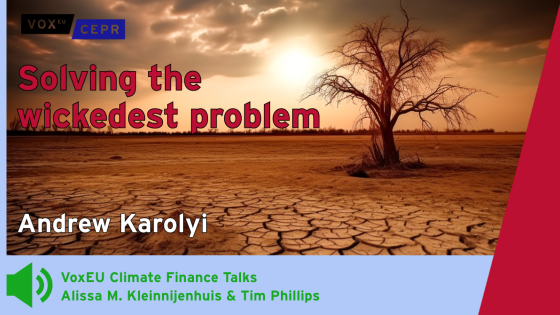Since the creation of the first central banks in the 19th century, the existence of a lender of last resort (LOLR) has been a key issue for the structure of the banking industry. Banks finance opaque assets with a long maturity with short-lived liabilities – a combination that is vulnerable to sudden loss of confidence. To avoid avoidable disasters when confidence evaporates, the classical view (Thornton 1802 and Bagehot 1873) is that the central bank should lend to illiquid but solvent banks, at a penalty rate, and against collateral deemed to be good under normal times.
With the development of well-functioning financial markets, this view has been considered obsolete. Goodfriend and King (1988) in particular argue that the central bank should just provide liquidity to the market and leave to banks the task of allocating credit and monitoring debtors. This view, however, assumes that interbank markets work perfectly and in particular are not plagued by asymmetric information – but that is one of the main reasons why banks exist. The problem with asymmetric information is that liquidity shocks affecting banks might be undistinguishable from solvency shocks, thus making it impossible to distinguish between illiquid and insolvent banks (Goodhart 1987 and Freixas, Parigi and Rochet 2004).
LOLR and bank closure policy
LOLR is thus connected with the efficient bank closure policy and, more generally, with the costs of bank failures and of the safety net. In cases of illiquidity, the LOLR is channelling liquidity and improving the efficiency of the monetary policy framework. In insolvency cases, the LOLR acts as part of a safety net and thus is directly related to the overall regulatory framework.
Clearly, the design of an optimal LOLR mechanism has to take into account both the banking regulation context and the monetary framework that is intended to cope not only with inflation but also with the management of aggregate liquidity.
These issues are compounded by the fact that financially fragile intermediaries are exposed to the threat of systemic risk. Systemic risk may arise from the existence of a network of financial contracts from several types of operations: the payment system, the interbank market, and the market for derivatives. The tremendous growth of these operations recent decades has increased the interconnections among financial intermediaries and among countries. This has greatly augmented the potential for contagion (Allen and Gale 2000 and Freixas, Parigi and Rochet 2000).
The panic of 2008 and subprime crisis of 2007
The panic of 2008, originating with the subprime crisis of 2007, offers key insights into systemic risk and illustrates vividly the new role of a lender of last resort.
Years of accommodating monetary policy, regulatory arbitrage to save capital, and waves of financial innovations – which by definition tend to escape traditional prudential regulation – have created the conditions for slack credit standards and rating agencies that fail to call for adequate risk premia.
The opacity of the assets of the banks and of the financial vehicles they created to hold mortgages resulted in a dramatic and sudden reappraisal of risk premia. As with a thin market typical of the Akerlof lemons problem (Freixas and Jorge 2007), financial intermediaries have become reluctant to lend to each other if not for very short maturities. The fear that the interbank market might not work well and might fail to recycle the emergency liquidity provided by the central banks around the world in various and coordinated ways has induced banks to choose the rational equilibrium strategy of hoarding some of the extra liquidity instead of recycling it to the banks in deficit.
The resulting equilibrium closely resembles the gridlock described by Freixas, Parigi and Rochet (2000), where the fear that a debtor bank will not honour its obligations induces the depositors of the creditor bank to withdraw deposits, thus triggering the liquidation of assets in a chain reaction. This is the modern form of a “bank run” – financial intermediaries refuse to renew credit lines to other intermediaries, thus threatening the very survival of the system.
Liquidity in a non-functioning interbank market
Clearly channelling emergency liquidity assistance through the interbank market will not work if the interbank market is not functioning properly. Thus, to limit the systemic feedbacks of the sudden deleveraging of financial institutions, the Fed has taken the unprecedented steps of both increasing the list of collateral eligible for central bank lending and extending emergency liquidity assistance to investment banks, government sponsored entities, money market mutual funds, and a large insurance company (AIG). Preventing a complete meltdown of the financial system has required the central bank to guarantee (and accept potential losses) that most if not all claims on financial institutions will be fulfilled.
The panic of 2008 has showed that it would be erroneous to adopt a narrow definition of the LOLR, stating that its role should be limited to the funding of illiquid but solvent depository institutions, while capital injections should be the Treasury’s responsibility. This would lead to a very simplistic analysis of the LOLR’s functions, as the complex decisions would be either ignored or handed over to the Treasury. Such a narrow view of the lender of last resort would create an artificial separation between lending by the lender of last resort at no risk and the closure or bail-out decision by the Treasury. In fact, the recent crisis has proved that the lender of last resort cannot deny support to a systemic, too-big-to-fail financial institution in need.
To understand the interventions of the lender of last resort in the current crisis, the view of its role has to be a broad one encompassing the closure or bail-out decision defining the lender of last resort as an agency that has the faculty to extend credit to a financial institution unable to secure funds through the regular circuit.
LOLR policy as part of the banking safety net
Once we establish that the lender of last resort policy has to be part of the overall banking safety net, the interdependence of the different components of this safety net becomes clear.
- First, the existence of a deposit insurance system limits the social cost of a bank’s bankruptcy, and therefore, reduces the instances where a LOLR intervention will be required.
- Second, capital regulation reduces the probability of a bank in default being effectively insolvent, and so has a similar role in limiting the costly intervention of the LOLR.
- Third, the procedures to bail-out or liquidate a bank, determined by the legal and enforcement framework will determine the cost-benefit analysis of a LOLR intervention.
Adopting a perspective of an all-embracing safety net does not mean that the safety net has to be the responsibility of a unique agent. Often several regulatory agencies interact, because different functions related to the well functioning of the safety net are allocated to different agents.
It is quite reasonable to separate monetary policy from banking regulation, and the separation of the deposit insurance company from the central bank makes the cost of deposit insurance more transparent. Also, the national jurisdiction of regulation makes cross-border banking a joint responsibility for the home and host regulatory agencies, an issue of particular concern for the banking regulatory authorities in the EU.
Lessons for the LOLR’s role
- First, we have witnessed how an additional aggregate liquidity injection is not a sufficiently powerful instrument to solve the crisis.
The illiquidity of financial institutions around the world is, in fact, directly linked not only to their solvency but also to asset prices.
- Second, central banks around the world have been much more flexible in providing support to the banking industry than initially expected.
In other words, that central bank cannot credibly commit to a bail-out policy. Indeed, the arguments regarding the bail-out of banks only if their closure could have a systemic impact (too-big-to-fail), that were intended for an individual bank facing financial distress were soon discarded in favour of a more realistic approach.
The case of Northern Rock, certainly not a systemic bank, illustrates this point. Its liquidation in such a fragile banking environment would have triggered a domino effect with contagion from one institution to another. From that perspective the lesson is that when facing a systemic crisis, the LOLR has to take into account also the “too-many-to-fail” issue, and consider how it will treat all banks that are in a similar position.
- A third point is that, in a systemic crisis, the safety net is extended to non-bank institutions.
This may be the result of financial innovation. Yet, because AIG had been issuing credit default swaps, its bankruptcy would have affected the fragility of the banking industry by leading to losses and a lower capital.
- Fourth, regulators around the world have a mandate to protect the interests of their national investors.
The international coordination of regulators, and in particular, the European coordination has been helpless when faced with the real cost of the Icelandic crisis. So, the theoretical models of non-cooperative behaviour are the ones to cope ex-ante with the burden-sharing issue.
Editor’s note: This article draws in part on the work Freixas and Parigi (2008).
References
Allen, F. and Gale, D. (2000). Financial Contagion, Journal of Political Economy, 108, 1-33
Bagehot, W. (1873). Lombard Street: A Description of the Money Market. London: H.S. King
Freixas, X. and Jorge, J. (2007). The role of Interbank Markets in Monetary Policy: A model with rationing, Journal of Money, Credit and Banking, forthcoming.
Freixas, X. and Parigi, B.M. (2008) “Lender of last resort and bank closure policy” CESifo working paper 2286, April 2008
Freixas, X., Parigi, B.M. and Rochet, J-C. (2000). Systemic Risk, Interbank Relations and Liquidity Provision by the Central Bank, Journal of Money, Credit and Banking August, 32, Part 2, 611-638
Freixas, X., Parigi, B.M. and Rochet, J-C. (2004). The Lender of Last Resort: A 21st Century Approach, Journal of the European Economic Association, 2, 1085-1115
Goodfriend, M. and King, R. (1988). Financial Deregulation Monetary Policy and Central Banking, in W. Haraf and Kushmeider, R. M. (eds.) Restructuring Banking and Financial Services in America, AEI Studies, 481, Lanham, Md.: UPA
Goodhart, C. A. E. (1987). Why do Banks need a Central Bank?, Oxford Economic Papers, 39, 75-89
Thornton, H. (1802). An Enquiry into the Nature and Effects of the Paper Credit of Great Britain, London: Hatchard



